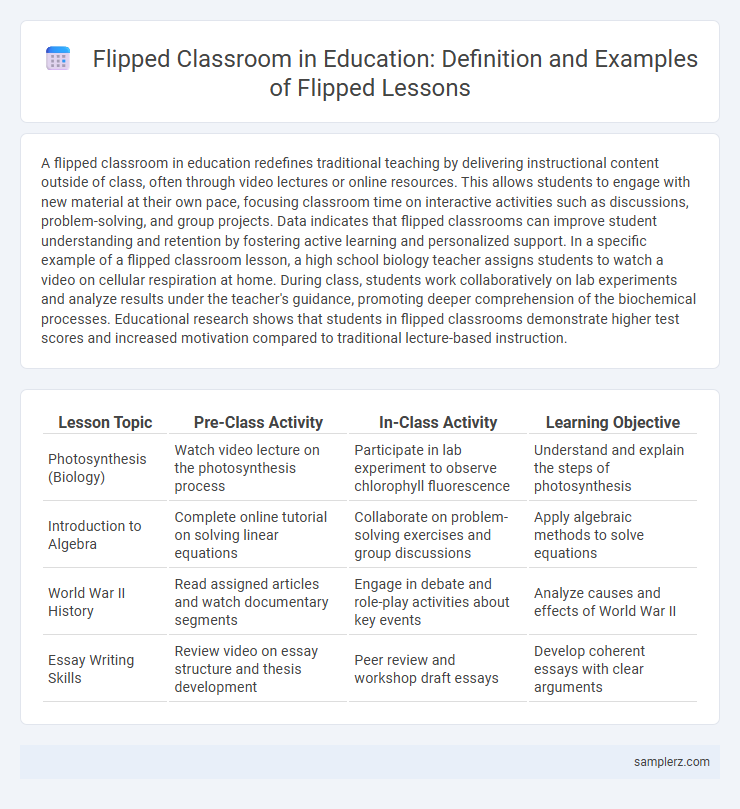A flipped classroom in education redefines traditional teaching by delivering instructional content outside of class, often through video lectures or online resources. This allows students to engage with new material at their own pace, focusing classroom time on interactive activities such as discussions, problem-solving, and group projects. Data indicates that flipped classrooms can improve student understanding and retention by fostering active learning and personalized support. In a specific example of a flipped classroom lesson, a high school biology teacher assigns students to watch a video on cellular respiration at home. During class, students work collaboratively on lab experiments and analyze results under the teacher's guidance, promoting deeper comprehension of the biochemical processes. Educational research shows that students in flipped classrooms demonstrate higher test scores and increased motivation compared to traditional lecture-based instruction.
Table of Comparison
| Lesson Topic | Pre-Class Activity | In-Class Activity | Learning Objective |
|---|---|---|---|
| Photosynthesis (Biology) | Watch video lecture on the photosynthesis process | Participate in lab experiment to observe chlorophyll fluorescence | Understand and explain the steps of photosynthesis |
| Introduction to Algebra | Complete online tutorial on solving linear equations | Collaborate on problem-solving exercises and group discussions | Apply algebraic methods to solve equations |
| World War II History | Read assigned articles and watch documentary segments | Engage in debate and role-play activities about key events | Analyze causes and effects of World War II |
| Essay Writing Skills | Review video on essay structure and thesis development | Peer review and workshop draft essays | Develop coherent essays with clear arguments |
Introduction to Flipped Classroom in Education
A flipped classroom model in education reverses traditional teaching by delivering instructional content, such as video lectures on introductory topics, outside of class. In an Introduction to Flipped Classroom lesson, students watch pre-recorded videos explaining core concepts before attending class. Classroom time is then dedicated to interactive activities, discussions, and hands-on practice, enhancing comprehension and engagement.
Benefits of Implementing Flipped Classroom Models
Flipped classroom models enhance student engagement by allowing learners to review instructional content at their own pace outside of class, promoting deeper understanding during interactive, in-class activities. This approach leads to higher retention rates and improved academic performance as students actively apply concepts through collaborative problem-solving and personalized feedback from instructors. Research indicates that implementation of flipped classrooms fosters critical thinking, increases motivation, and supports differentiated learning styles, making education more effective and inclusive.
Key Components of a Flipped Classroom Lesson
In a flipped classroom lesson, key components include pre-class instructional videos that introduce core concepts, allowing students to engage with the material at their own pace. During class, active learning activities such as problem-solving sessions and group discussions reinforce understanding and encourage collaboration. Formative assessments are integrated throughout to provide immediate feedback and guide personalized support.
Example: Flipped Math Lesson Structure
A flipped math lesson typically begins with students watching video tutorials on concepts like algebraic equations or geometry proofs at home, allowing them to learn at their own pace. In-class time is dedicated to solving practice problems, engaging in group discussions, and receiving personalized guidance from the teacher. This method enhances understanding of topics such as quadratic functions and linear transformations by fostering interactive application and immediate feedback.
Example: Flipped Science Classroom Activities
In a flipped science classroom, students watch instructional videos on concepts like photosynthesis at home, allowing class time for hands-on experiments and group discussions. For instance, after reviewing a video on chemical reactions, students perform lab activities to observe reactions firsthand, fostering deeper understanding. This approach enhances engagement and critical thinking by integrating multimedia learning with interactive, practical exercises.
Using Video Lectures for Pre-Class Learning
Video lectures serve as an effective tool for pre-class learning in flipped classrooms, allowing students to grasp foundational concepts at their own pace before face-to-face sessions. Teachers can assign curated video content that highlights key topics, enabling in-class time to focus on interactive discussions, problem-solving, and hands-on activities. This approach enhances student engagement and supports differentiated instruction by accommodating diverse learning styles and speeds.
Interactive In-Class Activities in Flipped Lessons
Interactive in-class activities in flipped lessons often include collaborative group projects, problem-solving exercises, and hands-on experiments that reinforce pre-learned content. Students engage directly with the material through peer discussions, case studies, and real-time feedback, which deepens comprehension and critical thinking skills. Technology tools like interactive polls and digital whiteboards facilitate active participation and immediate assessment during these sessions.
Assessing Student Understanding in Flipped Classrooms
In flipped classrooms, assessing student understanding often involves formative assessments such as quizzes or interactive polls administered after students review video lectures at home. Teachers use online platforms to track student performance and identify areas needing clarification before in-class activities. This approach promotes active learning and allows educators to tailor in-class discussions to address specific misconceptions effectively.
Overcoming Challenges in Flipped Classroom Implementation
Teachers often face resistance from students unaccustomed to active learning, which can be mitigated by gradually integrating multimedia resources and interactive quizzes to boost engagement. Practical challenges like limited access to technology are addressed by providing offline materials and facilitating peer-supported study groups. Continuous feedback mechanisms and professional development workshops empower educators to refine flipped classroom practices, ensuring smoother implementation and improved learning outcomes.
Tips for Designing Effective Flipped Classroom Lessons
In designing effective flipped classroom lessons, instructors should create concise, engaging video content that clearly explains key concepts, allowing students to learn at their own pace before class. Incorporating interactive quizzes and prompts within the videos helps reinforce understanding and keeps students actively involved. Planning collaborative, hands-on activities for in-class sessions maximizes the application of knowledge and fosters deeper critical thinking skills.

example of flipped classroom in lesson Infographic
 samplerz.com
samplerz.com